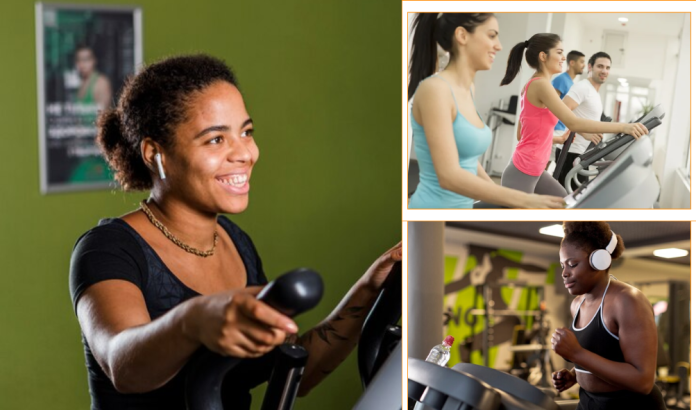Find out “Optimal Treadmill Workout Times for Weight Loss” The rhythmic thump of your feet hitting the treadmill, the satisfying whir of the machine – treadmills have become a mainstay in many weight loss journeys. But have you ever wondered if there’s a “magic hour” for maximizing your treadmill workouts? As a health researcher, I’m here to tell you that the answer is both fascinating and personal.
This article will guide you on a journey to find your weight-loss rhythm on the treadmill. We’ll explore the science behind timing, delve into different time-based options, and help you identify what works best for your unique body and lifestyle. We’ll also equip you with strategies to energize your workouts, navigate the walking vs. running debate, and unlock the full potential of your treadmill for incredible results.

Unveiling the Science Behind Timing
Our bodies are like finely tuned instruments, operating on a 24-hour internal clock known as the circadian rhythm. This rhythm influences various processes, including metabolism and energy expenditure. Recent research suggests that exercise timing might play a role in weight loss.
A 2022 study published in the MDPI [1] explored the effects of morning workouts on overweight men. The study found that those who exercised in the morning burned more fat compared to those who exercised later in the day. While the exact mechanisms are still being explored, these findings hint at the potential benefits of aligning your workouts with your circadian rhythm.
However, it’s important to remember that research in this area is ongoing, and the “best” time to exercise might vary based on individual factors. Don’t get discouraged if morning workouts don’t feel right for you – there are other ways to find your weight-loss rhythm on the treadmill.
Exploring the Time-Based Options
Let’s delve into the pros and cons of different workout times to help you decide which might be the best fit for you:
Morning Workouts: Seize the Day
- Potential Benefits:
- Boosts Metabolism: Early exercise might give your metabolism a kickstart, potentially leading to increased calorie burning throughout the day [2].
- Improves Focus: A morning sweat session can leave you feeling energized and mentally sharp, aiding in focus and productivity for the rest of the day.
- Challenges:
- Early Bird Blues: Waking up for a pre-dawn workout can be tough for some. Don’t be afraid to ease into it – start with shorter workouts and gradually increase the duration.
- Hydration is Key: Remember, you’ve likely been sleeping for several hours, so proper hydration before your workout is crucial. Aim for a glass of water before hitting the treadmill.
Afternoon Workouts: Power Through Your Lunch Break
- Potential Benefits:
- Challenges:
- Post-Lunch Slump: If you have a heavy lunch, you might feel sluggish. Opt for a light, healthy meal beforehand to avoid digestive discomfort.
- Scheduling Conflicts: Midday workouts can clash with work schedules. Consider shorter, focused sessions or explore options for flexible work hours.
Evening Workouts: Unwind and Recharge
- Potential Benefits:
- Stress Relief: Exercise is a great way to de-stress after a long day. An evening workout can help you unwind and prepare for a good night’s sleep.
- Challenges:
- Sleep Disruption: Intense evening workouts can interfere with sleep quality. Aim for workouts at least a few hours before bedtime and opt for a cool-down routine to signal to your body that it’s time to wind down.
Finding Your Personal Best
Now that you’ve explored the different time options, it’s time to discover your personal sweet spot. Here are some tips:
- Listen to Your Body: Pay attention to your energy levels throughout the day. Are you a morning person or a night owl?
- Consider Your Schedule: Be realistic about your commitments and find a time that fits seamlessly into your daily routine.
- Experiment and Track: Try different workout times and track your progress. How do you feel after each session? Does it impact your sleep or energy levels?
Energize Your Treadmill Sessions: Strategies for Success
No matter when you choose to exercise, here are some tips to keep your workouts energized:
- Morning: If early mornings feel like a struggle, try a pre-workout routine like light stretches or a quick walk outside to get your blood flowing. A glass of cold water can also help jumpstart your metabolism.
- Afternoon: Opt for a light, protein-rich lunch like a Greek yogurt with berries or a grilled chicken salad. Avoid heavy carbs that can lead to a post-lunch slump. If you’re short on time, a piece of fruit with a handful of almonds can provide a quick energy boost.
- Evening: Schedule your workout at least 2-3 hours before bedtime. Focus on moderate-intensity exercise rather than high-intensity workouts that can leave you feeling wired [5]. A cool-down walk with some static stretches can help your body transition into relaxation mode.
Walking vs. Running for Weight Loss
The good news is that both walking and running can be incredibly effective for weight loss. Here’s a breakdown of each:
- Walking:
- Benefits: Walking is a low-impact exercise that’s easy on your joints. It’s a great option for beginners or those recovering from injuries. Brisk walking can burn a significant amount of calories, especially when done consistently.
- Getting Started: Begin with a comfortable pace and gradually increase the speed and duration of your walks as your fitness improves. Consider incorporating incline variations for an added challenge.
- Running:
- Benefits: Running offers a more intense workout, burning more calories per minute compared to walking [6]. It can also help build muscle, which further boosts your metabolism.
- Getting Started: If you’re new to running, start with a walk/run interval program. Alternate between walking and running intervals to build your endurance gradually. Proper running form is crucial to prevent injuries; consult a running coach or trainer for guidance.
Pro Tips for Treadmill Mastery
Now that you’ve identified your workout time and chosen your pace, let’s unlock the full potential of your treadmill:
- Interval Training: Incorporate interval training for a calorie-burning boost. Alternate between periods of high-intensity effort (running) and periods of recovery (walking or jogging). This keeps your heart rate elevated and burns more calories in a shorter time.
- Incline Variations: Don’t underestimate the power of incline! Adding an incline to your walk or run mimics uphill terrain, engaging more muscle groups and burning more calories. Start with a low incline and gradually increase it as you get stronger.
- Heart Rate Monitoring: Many treadmills have built-in heart rate monitors. Utilize this feature to stay within your target heart rate zone for optimal fat burning.
- Workout Programs: Explore pre-programmed workouts on your treadmill. These often offer a variety of intensities and durations to keep your workouts interesting and challenging.
- Form is Key: Maintaining proper running form is essential to prevent injuries. Pay attention to your posture, footstrike, and arm swing. Don’t hesitate to consult a trainer for personalized guidance.
Beyond the Basics: Unleashing the Full Potential of Your Treadmill Workouts
Your treadmill can be more than just a running machine. Here’s how to expand your workouts:
- Strength Training: Integrate strength training exercises with your treadmill sessions for a complete workout. Use dumbbells or resistance bands to work your upper body while walking or jogging on a low incline.
- HIIT Workouts: High-Intensity Interval Training (HIIT) offers a time-efficient way to maximize calorie burning. Utilize the interval training function on your treadmill to create a custom HIIT workout.
- Creative Resources: Don’t let treadmill workouts get monotonous! Explore fitness apps and online platforms that offer a variety of treadmill workout routines, including scenic virtual runs and interval training programs.
Key Takeaways
- Circadian Rhythms Influence Workout Timing: Your body’s internal clock can affect how you respond to exercise, suggesting that certain times of day might be more conducive to weight loss efforts.
- Variety in Workout Types: Treadmill workouts for weight loss can range from low-intensity steady-state walking to high-intensity interval training (HIIT), offering flexibility to suit different schedules and preferences.
- Consistency Over Timing: While timing can play a role, the most important factor for weight loss is consistency in your workout routine. Spending 30 minutes per day on a treadmill can help you start losing weight by creating a calorie deficit.
- Programming and Timing: The timing of your treadmill workouts can be adjusted based on your goals and schedule. For example, high-intensity workouts can be performed in shorter durations, and moderate-intensity workouts can be extended with additional walks throughout the day.
- Nutrition and Workout Combination: While treadmill workouts are effective for weight loss, it’s crucial to complement these efforts with a balanced diet. Nutrition plays a key role in achieving and maintaining weight loss goals.
FAQs
Q: How long should my treadmill workouts be for weight loss?
A: Aim for at least 30 minutes of moderate-intensity exercise most days of the week. You can break this down into shorter sessions if needed.
Q: How often should I use the treadmill for weight loss?
A: Consistency is key! Aim for at least 3-5 treadmill workouts per week for optimal weight loss results.
Q: What should I eat before and after my treadmill workout?
A: Pre-workout: For morning workouts, some water or a light snack might suffice. Afternoon workouts might benefit from a light, protein-rich meal. Post-workout: Replenish your energy stores with a balanced meal containing carbohydrates and protein.
Conclusion
Finding the right time to exercise and maximizing your treadmill workouts takes some experimentation and personal tweaking. Listen to your body, choose a schedule that fits your lifestyle, and don’t be afraid to experiment with different routines. Remember, consistency is key! Aim for regular treadmill sessions that you enjoy – after all, exercise shouldn’t feel like a chore.
The most important? Focus on progress, not perfection. Celebrate your achievements, big or small, and enjoy the journey towards a healthier, fitter you. If you have any underlying health conditions, consult your doctor before starting a new exercise program. They can help you create a safe and effective workout plan tailored to your individual needs.
So, lace up your shoes, hit the treadmill, and find your weight-loss rhythm. With dedication and the right strategies, you’ll be well on your way to achieving your fitness goals!



